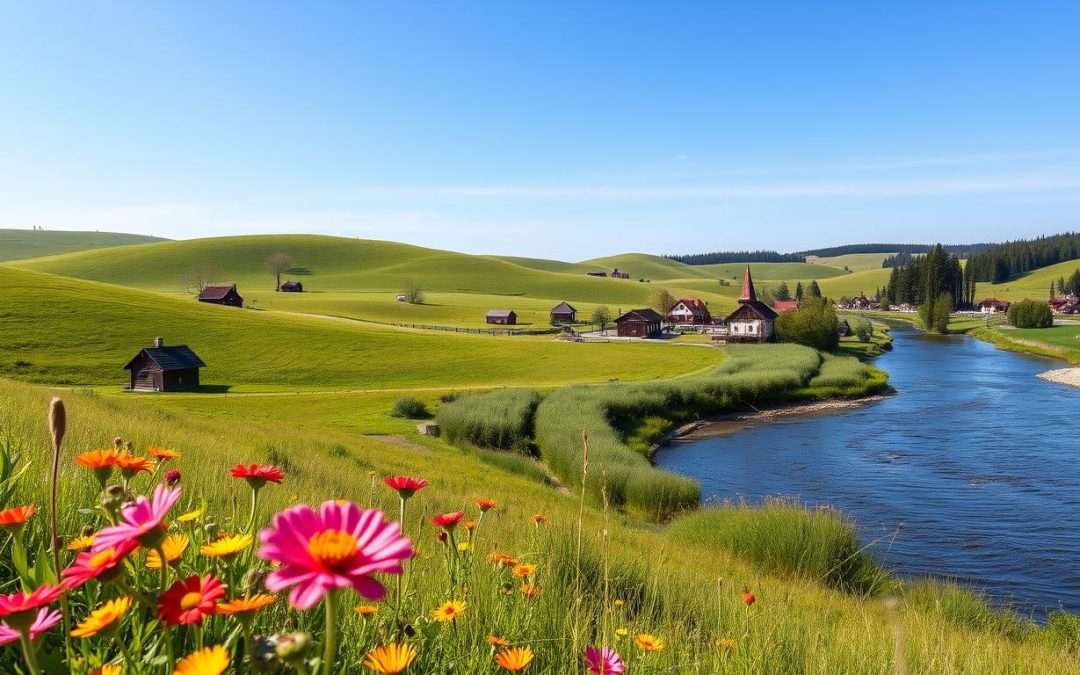Ever wondered about the languages in a nation at the crossroads of Eastern Europe? In Belarus, it’s more complex than you think.
Belarus has a unique mix of two official languages: Belarusian and Russian. This creates a rich communication landscape. With about 9.5 million people, the country’s language evolution shows its complex history and politics.
Belarusian is still an official language, but its use has dropped a lot. In 1994, 40% of students learned in Belarusian. Now, it’s less than 9%. Russian has become more common in public life, changing Belarus’s language identity.
Key Takeaways
- Belarus has two official languages: Belarusian and Russian
- Linguistic usage has shifted dramatically since the 1990s
- Urban areas predominantly use Russian
- Language choice can reflect political sentiments
- The country maintains a complex linguistic heritage
The Language Landscape of Modern Belarus
Belarus is a place of rich language diversity. Here, different tongues blend together, showing the nation’s complex cultural roots. This mix of languages shapes how people interact and defines the country’s identity.
Current Language Demographics
The language scene in Belarus is quite interesting. Here are some key facts:
- Russian is spoken by about 70% of people at home
- Belarusian is the first language for 53.2% of the population
- Around 26% of people often use Belarusian
Urban vs Rural Language Distribution
In Belarus, language use changes a lot between cities and countryside. Cities mostly use Russian, but rural areas stick to Belarusian. This shows how history and culture have shaped language use.
Contemporary Language Usage Patterns
In Belarus, Russian is the main language for work and government. Even though Belarusian is an official language, it’s not used as much as Russian.
“Language is the roadmap of a culture. It tells you where its people come from and where they are going.” – Rita Mae Brown
Belarus faces a big challenge. It needs to keep its language diversity alive while dealing with the daily mix of Russian and Belarusian.
Historical Evolution of Languages in Belarus
The language history of Belarus is rich and complex, spanning centuries. It starts with documents from the 12th century, written in Church Slavonic.
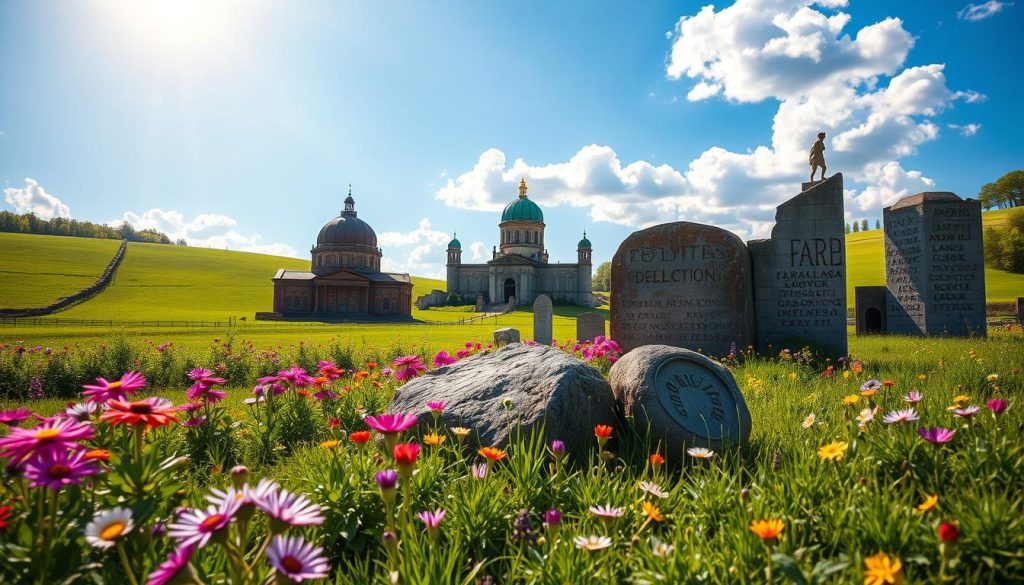
Belarus saw big changes in its language over time. These changes were shaped by politics and culture:
- 12th-14th centuries: Church Slavonic was used in official documents.
- Late 14th-15th centuries: Belarusian language started to show its own traits.
- 1696: Ruthenian was banned in official papers.
- 19th century: The Romantic movement helped create a modern Belarusian literature.
“Language is the road map of a culture. It tells you where its people come from and where they are going.” – Rita Mae Brown
The language of Belarus has been shaped by politics. Russian and Polish had a big impact, especially when they ruled.
| Period | Linguistic Characteristic | Key Development |
|---|---|---|
| 12th Century | Church Slavonic Texts | Earliest Known Documents |
| Late 14th Century | Distinctive Belarusian Features | Linguistic Differentiation |
| 1905 | Printing Restrictions Lifted | Literary Language Development |
By the late 20th century, Belarus’s language policies changed a lot. The 1995 referendum made Belarusian and Russian official languages. This shows the complex identity of the nation.
Belarusian Language: Heritage and Development
The Belarusian language is a vibrant part of Belarus’s rich culture. It is one of Eastern Europe’s native tongues. It connects generations and keeps national memories alive.
Origins and Early Development
Belarusian comes from the East Slavic language family. It started from Old East Slavic. The language was shaped by many cultural and political changes.
- First documented in the 14th century
- Developed from Old Slavic dialects
- Influenced by neighboring linguistic traditions
Modern Belarusian Language Features
The modern Belarusian language has unique features. It shows both its traditional roots and modern changes.
| Language Characteristic | Details |
|---|---|
| Alphabet | 32 letters, established in 1918 |
| Speakers Globally | Approximately 2.5 million |
| Mutual Intelligibility | 55% with Polish |
Cultural Significance and Preservation
Belarusian linguistics is key to national identity. It’s more than just talking—it connects us to our cultural heritage.
“Language is the road map of a culture. It tells you where its people come from and where they are going.” – Rita Mae Brown
Even though only 23% of Belarusians speak Belarusian daily, 40% see it as their ethnic language. This shows the effort to keep this important language alive.
Russian Language Dominance in Belarus
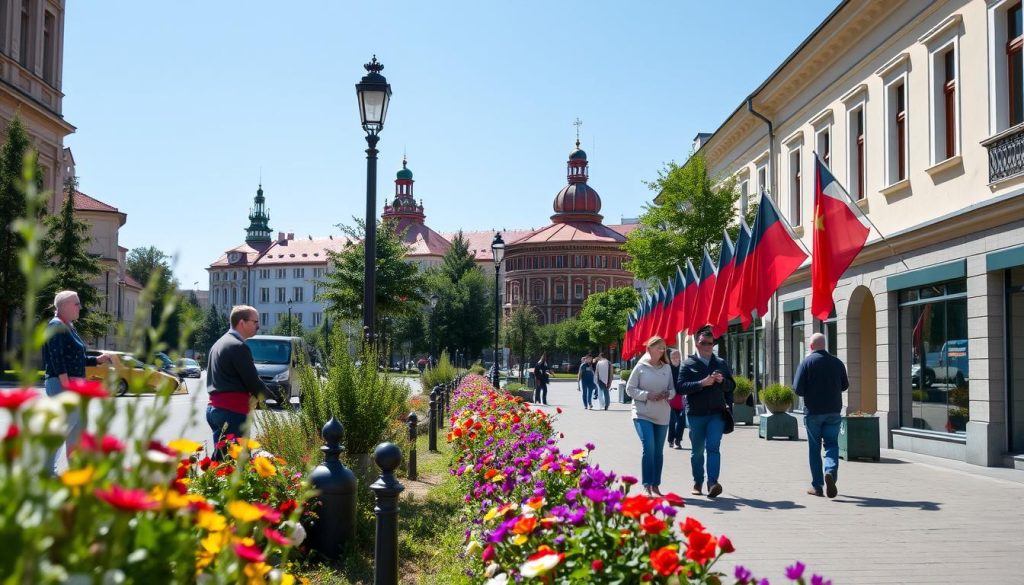
Belarus has a unique language scene, with Russian at the forefront. A 1995 referendum made Russian an official language, with 88.3% of voters agreeing. This move gave Russian and Belarusian equal legal status.
The Russian language’s strong presence in Belarus comes from its long history. Here are some key facts:
- 70.2% of the population speaks Russian at home
- 41.5% of Belarusians declared Russian as their mother language
- 85% of published books are in Russian
- More than 72% can understand and use Russian
The Soviet era played a big role in Russian’s popularity. Schools mainly taught in Russian after World War II. This made Russian a big part of everyday life.
| Language Metric | Percentage |
|---|---|
| Russian Home Language Usage | 70.2% |
| Russian Mother Tongue | 41.5% |
| Books Published in Russian | 85% |
Even with efforts to increase language diversity, Russian is still the main language used. It’s seen in work, school, and media. This shows Belarus’s complex ties with Russia.
“Language is a powerful reflection of cultural identity and historical connections.” – Linguistic Expert
Belarus: Official and Widely Spoken Languages
Belarus’s language scene is complex, showing a mix of history and today’s society. It’s a blend of past influences and current social life.
Legal Status of Languages
In Belarus, both Belarusian and Russian are official languages. A big vote in 1995 made them equal. Now, both languages are used a lot in schools, government, and media.
- Belarusian: The national language with historical roots
- Russian: Widely spoken and administratively prevalent
- Multilingualism: A defining characteristic of Belarusian society
Implementation in Public Institutions
In public places, Russian is mostly used, even though Belarusian is official. Recent surveys show a big change in language use:
| Language | Home Usage in 1999 | Home Usage in 2009 |
|---|---|---|
| Belarusian | 36.7% | 11.9% |
| Russian | 58.6% | 69.8% |
Language Rights and Policies
Belarus has a balanced view on language rights. Russian is used more in public life. The government’s language rules have shaped the current language scene.
“Language is not just a communication tool, but a reflection of cultural identity” – Belarusian Language Researcher
Understanding Belarus’s language scene shows a mix of history and today’s rules.
Language Education System in Belarus
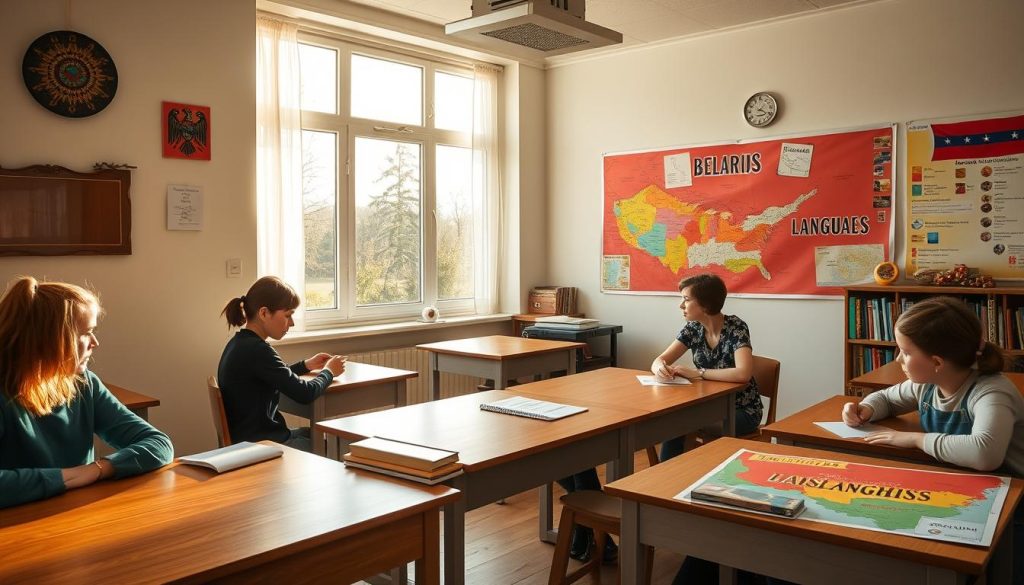
Belarus has a detailed education system that shows its unique language mix. It balances keeping cultural heritage alive with new teaching methods.
The education system in Belarus covers many stages of learning languages. With 90.8% of students getting their education rights, it offers strong learning chances for all.
“Education is the passport to the linguistic diversity of Belarus” – Belarusian Educational Philosophy
Key Educational Language Characteristics
- Primary education achievement: 85.2%
- Secondary education achievement: 96.3%
- Kindergarten attendance: 70% for children aged 3-5
- Languages of instruction: Belarusian and Russian
Educational Structure
| Education Stage | Duration | Age Range |
|---|---|---|
| Primary Education | 4 years | 6-10 years |
| Basic Secondary Education | 5 years | 10-15 years |
| General Secondary Education | 2 years | 15-17 years |
Higher education in Belarus offers special language chances. There are 55 higher education places (45 state, 10 private) where students can learn in Belarusian and Russian. To get in, students must pass three tests, scoring up to 100 points each.
The language scene in Belarus’s education is fascinating. Russian is still the main language, but there’s a push to keep Belarusian alive and diverse.
Minority Languages and Their Communities
Belarus is a place of rich language diversity. Here, minority languages help keep cultural heritage alive. The country’s language scene goes beyond its two official languages. It shows a colorful mix of languages that make up the nation’s identity.
Polish Language Communities
In Belarus, many people speak Polish, mainly in the west. They work hard to keep their culture alive through language. Their efforts show how diverse the region’s languages are. Many Polish speakers also take part in local events and activities.
- Concentrated in western border regions
- Active cultural preservation initiatives
- Strong community networks
Ukrainian Speaking Population
Ukrainian speakers are another key group in Belarus. They live mostly in the south, near Ukraine. They keep their language alive while also joining in with Belarusian life. This adds to Belarus’s rich mix of languages and cultures.
| Region | Ukrainian Speaker Concentration |
|---|---|
| Southern Belarus | Highest Ukrainian language presence |
| Border Areas | Strong linguistic connections |
Yiddish Language Heritage
Yiddish is a language with deep roots in Belarus, showing the country’s Jewish history. Though fewer people speak it now, efforts to save it continue. Yiddish is a vital part of Belarus’s language diversity, linking today’s people to their past.
Language is the road map of a culture. It tells you where its people come from and where they are going. – Rita Mae Brown
These minority language groups show Belarus’s dedication to language diversity. They prove how different languages can live together and enrich the nation’s culture.
Trasianka: The Unique Belarusian-Russian Mixed Speech
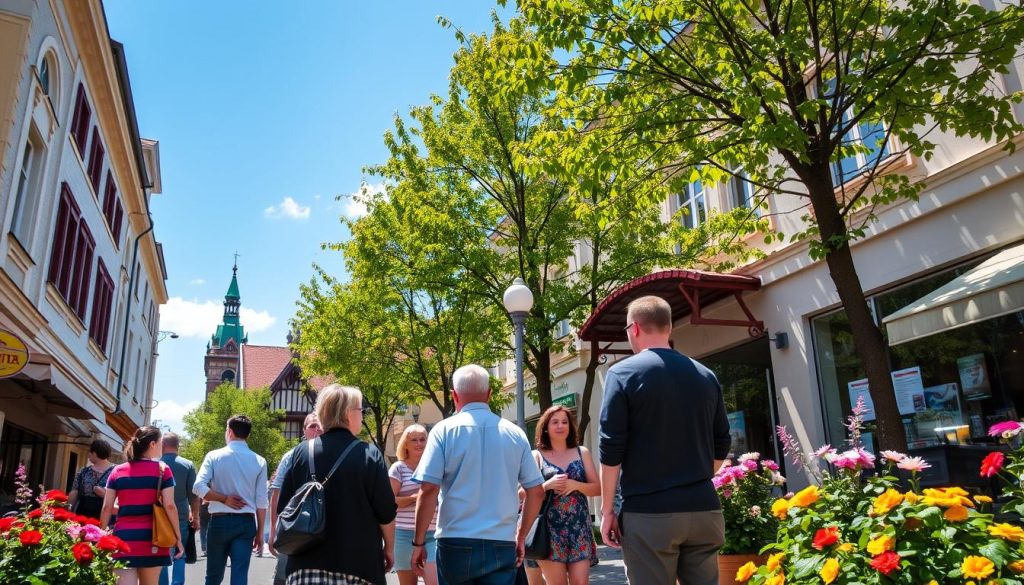
Trasianka is a unique mix of Belarusian and Russian languages in Belarus. It shows how two Slavic languages blend in a special way. This mix comes from the complex language scene in Belarus.
The start of Trasianka is tied to people moving from rural areas to cities. Belarusian speakers moved to cities where Russian was more common. This led to a new way of speaking that mixed both languages.
- Combines grammatical structures from Belarusian and Russian
- Primarily used in informal communication settings
- Reflects sociolinguistic changes in Belarus
- Represents a living example of language diversity
Linguists see Trasianka as more than a simple dialect. It’s a complex way of speaking that shows how language changes in Belarus. It breaks down old language barriers, showing how we talk changes with society.
“Trasianka is not a mistake, but a living linguistic reality that captures the essence of Belarus’s language diversity.” – Language Scholars
In cities, Trasianka helps people talk across language gaps. It shows the mix of cultures in modern Belarus. Its use shows the ongoing talks about language in a country rich in language history.
| Language Aspect | Trasianka Characteristics |
|---|---|
| Origin | Rural-urban linguistic interaction |
| Primary Users | Working-class migrants, urban populations |
| Linguistic Structure | Flexible blend of Belarusian and Russian |
| Social Significance | Cultural adaptation and communication |
Learning about Trasianka gives us a peek into Belarus’s lively language world. It shows how language changes through social talks and cultural sharing.
Language Policy Changes Since Independence
Belarus has seen big changes in its language policies since 1991. At first, there was hope to bring back the Belarusian language. But, political changes soon changed things.
The history of language policies in Belarus is complex. In the early 1990s, there was a short time of hope. The National Program wanted to make Belarusian more common in schools and public places.
“Language is the soul of a nation” – Traditional Belarusian proverb
Important changes in Belarus’s language policies include:
- 1991: Belarusian was promoted as the main official language.
- 1995: Russian was made a co-official language again.
- 2023: Russian is still more common in public life.
| Year | Language Policy Milestone | Impact |
|---|---|---|
| 1991 | Independence Declaration | Initial Belarusian language promotion |
| 1994 | Constitutional Changes | 40% of students taught in Belarusian |
| 2023 | Current Situation | Less than 9% of students in Belarusian |
The language scene in Belarus has changed a lot. Political pressures have made Belarusian less important. Now, Russian is more common in official and daily life.
It’s interesting that speaking Belarusian is seen as a political statement. The language policies have made Belarusian less official. It’s now seen as a symbol of cultural resistance.
Impact of Language Choice in Daily Life
Language diversity in Belarus shapes our daily lives in many ways. It affects our work, social interactions, and what we see in the media. The language we choose can change how we connect and what opportunities we find.
Professional Communication Dynamics
In Belarus, picking the right language can shape your career. Russian is the main language in most jobs, used in about 95% of state work. Knowing more than one language can give you an edge, especially in:
- Government institutions
- Corporate environments
- International business sectors
Social Interaction Patterns
Social talks in Belarus show a mix of languages. Russian is common, but Belarusian keeps cultural roots alive. Social media and everyday chats often mix languages, creating special ways of talking.
Media and Entertainment Landscape
The media in Belarus mostly uses Russian, with little Belarusian content. You might watch:
- Russian-language television channels
- Bilingual online platforms
- Niche cultural programming
“Language is the soul of a nation” – Belarusian Intellectuals, 1986
| Language | Home Usage | Professional Prevalence |
|---|---|---|
| Russian | 69.8% | High |
| Belarusian | 23% | Limited |
Knowing about these language patterns helps us understand Belarus’s rich communication world. It shows how language, culture, and identity are connected.
Language Preservation Efforts and Initiatives
In Belarus, saving the language is a big deal for culture lovers and linguists. The Belarusian language is facing big challenges to stay alive and important today. But, many efforts are underway to keep and bring back the language’s heritage.
Some key efforts include:
- Community-driven language education programs
- Digital platforms promoting Belarusian language learning
- Cultural events celebrating linguistic diversity
- Grassroots movements supporting language rights
The UNESCO Interactive Atlas of the World’s Languages in Danger called Belarusian ‘vulnerable’ in 2013. This shows how urgent it is to save the language. Now, language policies are working to help Belarusian language grow.
“Language is the roadmap of a culture. It tells you where its people come from and where they are going.” – Rita Mae Brown
Experts say there are important ways to keep the language alive:
- Starting bilingual education programs
- Supporting media in Belarusian
- Creating digital tools for learning
- Hosting cultural events to boost pride in language
Even with big challenges, these efforts show a strong will to save Belarus’s language. You can help by supporting local projects and exploring Belarusian culture.
Conclusion
Your journey through Belarus’s linguistic world shows a complex and dynamic scene. The official languages, Belarusian and Russian, are more than just ways to talk. They carry deep cultural and historical stories. Despite challenges, the variety of languages is key to the nation’s identity.
Statistics show a detailed view of language use in Belarus. Less than 20% speak Belarusian every day, showing a big challenge. But, social media trends during big events show a growing interest in native languages. This shows the Belarusian language community’s strength.
To understand Belarus’s language scene, we must see how official and minority languages interact. This includes Polish and Ukrainian. The shifts in language use show deeper cultural changes. It shows how language heritage keeps national identity alive.
Belarus’s language journey is complex, but it’s also a story of cultural preservation and change. The future of Belarus’s language scene is a story of resilience, identity, and communication.
The above is subject to change.
Check back often to TRAVEL.COM for the latest travel tips and deals.
